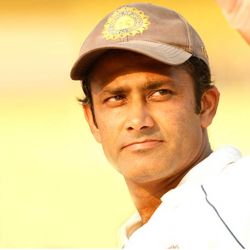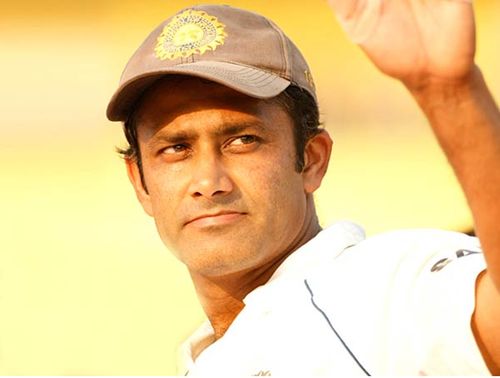
An epistle to Anil Kumble, the great granddad of Indian cricket

Anil Kumble redefined the art if leg spin more than anyone
Dear Jumbo,
India’s longest running soap opera – cricket – has produced a multitude of characters, but only a handful with unflinching determination and a dignified persona. Allying the aforementioned twain and rendering sublime performances on the field catering to a hypersensitive nation like India could be more than daunting. The endeavour to pen down my thoughts on you – Anil Radhakrishna Kumble – seems to be a herculean task, as I am callow to the art of writing. This is not a tribute but an unfeigned effort to metaphrase the visceral feelings of an ardent cricket lover in the form of an open letter.
India’s love affair with spin bowling dates back to the 1960s, when the interest towards the game had risen to unprecedented levels due to the spin quartet of Erapalli Prasanna, B.S. Chandresekhar, Srinivas Venkataraghavan and Bishan Singh Bedi. The following three decennaries were predominated by intimidating fast bowlers who had vehement dispositions to hammer a batsman’s skull. It was an era when leg spin was not only rare but considered obsolete, although a wily Pakistani named Abdul Qadir made sure he kept the torch alight for a generation of leg spinners to follow.
As cricket rolled into the nineties the game was blessed with the holy trinity of Shane Warne, Muttiah Muralitharan, and yourself. The triumvirate has accounted for more than two thousand victims in the game’s purest format. I often cudgel my brain as to why you are not spoken in the same breath as Murali or Warne.
In an era where flat wickets, shorter boundaries, bigger bats and field restrictions in one day cricket have been highly benevolent to the batsmen, your exploits with the red cherry for almost two decades in the international circuit seem to be larger than life. The indefatigable energy to hurl down incessant bullets with pinpoint accuracy has offered your opponents no leeway. This has led critics to censure your bowling style calling it ‘unidimensional’, a frivolous remark to say the least. Your prowess to extract vicious bounce from the pitch has bamboozled even cricket’s most illustrious batsmen.
While Shane Warne had the impeccable Glenn McGrath to dismantle the top order, you had to provide succour to our mercurial pace attack. With the lack of teeth in the bowling battalion and our batting proving fragile overseas for the most part of your career, you were coerced to damage control mode rather than to hound for wickets.
As a decade wore on, and when team India started to look at the world in the eye with a formidable batting line-up under the gritty leadership of Sourav Ganguly, you were given the carte blanche to experiment and express yourself on the world stage. New varieties were augmented to your bowling as you expanded your range, looked to bowl more googlies, slowed down the pace and tossed the ball up a bit more, which you could not afford to do in the earlier years. The stats do tell a tale: your first 84 Tests yielded you 397 wickets at a strike rate of 67.1, whereas your strike rate dipped by a whopping eight points to 59 in the final phase, which is almost at par with Shane Warne’s career strike rate.
You may not have possessed the Midas touch of Warne, who can even turn the sphere on a glass plate, but you are the master of a unique art. In the modern age where huge turners call the shots, your presence at the acme of the sport is a testament to your ingenuity. People who called you as a run-of-the-mill spinner were made to shut their mouths as the ball did all the talking for you. It is not just turn and flight that can deceive a batsman but variations in length and pace, as well: an edifying literature that you have taught for the generation of spinners to follow.
The adulation that batsmen receive in India due to our parochial attitudes has made you to lurk in their shadows. “If Kumble was born in Australia or England, he would have got much more prominence in world cricket considering his superb record in both forms of the game. Kumble is definitely the best role model for any youngster entering the game,” said Arjuna Ranatunga. The stirring spells you carved out at Headingley, Adelaide, Multan and Kingston brought us crowning victories overseas, which were primarily overshadowed by your comrade-in-arms- Rahul Dravid. The dearth of accolades never bothered you as you went from strength to strength by toppling batting line-ups around the world.
Given the opportunity to lead the nation during the autumn of your career, you brought the dogged spirit and dignity which defined you as a player. Your astute leadership almost led us to conquer the final frontier Down Under but for a horrendous display of umpiring by Steve Bucknor and Mark Benson.
The ability to come out unscathed and unflustered through major upheavals and to stand tall amidst the ruins has been the hallmark of your glittering career. One of the images that immediately flow into my mind is that of a wounded warrior (you) with a broken jaw and a bandaged face outfoxing Brian Lara at Antigua.
You have been an unconventional spinner, who is adept at his own art and a master of its nuances and intricacies. The subtle variations which you bring to the fore are far more apparent to cricket connoisseurs than nescient viewers. This is perhaps why you were unable to invoke the same emotional resonance which Warne or Murali did.
Like Warne’s ‘Ball of the Century’ and Murali’s fabulous 800, your ‘Perfect 10′ at Kotla against arch-rivals Pakistan is bound to stand the test of time and would be the folktale for aspiring spinners in the years to come. If ‘Tendulkar’ was our god, ‘Dravid’ our wall, ‘Laxman and Ganguly’ the pillars of our batting, you were the great granddad who guided us with your noble art and wisdom. You have indisputably been the greatest match winner we produced in whites. Thank you Anil Kumble for dignifying the sport more than ever.
Yours truly,
Raaghul Ramani